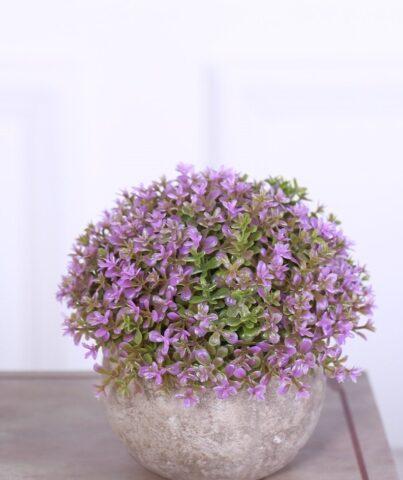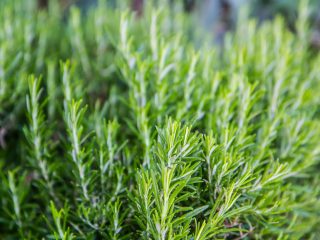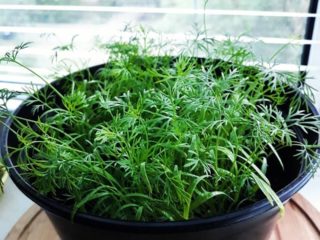Content
Many housewives grow thyme in a pot. The culture is often used as a spice in cooking; it is valued for its pleasant aroma and unique taste. In addition, thyme has medicinal properties, is used to treat respiratory diseases, and relieves problems in the digestive system. For people who frequently consume grass, it is useful to know how to easily grow it at home.

Thyme is a perennial crop of the Yamaceae family.
Is it possible to grow thyme at home?
Every housewife can grow thyme (Thymus) at home in a pot. To do this, you just need to familiarize yourself with agricultural technology and the rules of crop care and try to conscientiously follow them. The plant is perfect for planting at home; it is unpretentious and does not require special care.For a good harvest, you just need to take a suitable container, plant the spice in nutritious soil, place it in a well-lit place, periodically water it and feed it from time to time.
In addition to the fact that thyme is used for various purposes, it is also a neat and beautiful plant. Its compact bushes with small leaves have delicate inflorescences and fit perfectly into the interior. Thyme grows indoors all year round.
Thyme varieties for growing at home in a pot
Breeders have bred about two hundred different varieties of thyme, which taste not only of thyme, but also of orange, mint, and lemon. They differ in ripening period, characteristics, and purpose.
To plant thyme at home for further use, you should take any edible variety of the crop. Although there are several varieties that are more popular for these purposes. Small thyme with erect stems is best suited for home growing, for example:
- Lemon (citriodorus). It has a pleasant citrus smell and tart taste. It is distinguished by slightly pubescent leaf blades.
Lemon thyme was created by crossing common and flea thyme.
- Common (vulgaris). It is a low-growing bush, has a slightly pungent taste and a strong aroma. Ripens at the end of summer.
Common thyme is most often planted at home.
- Medok. It brings a bountiful harvest, blooms with pink inflorescences, and is a creeping crop.
Medoc thyme leaves with a slightly purple tint
- Creeping (serpyllum).The low bushes of the variety grow to a maximum height of 15 cm; fruits form on them in July.
The creeping species is planted both at home and in garden plots
- Snake (zmejka). Quickly produces greenery suitable for cutting, characterized by small leaves and bright purple-pink flowers.
The Snake variety has creeping shoots
- Rainbow. It has a pleasant aroma and contains many useful substances.
The Rainbow variety is often called a vegetable variety
- Aibolit. An early, abundantly leafy variety with delicate pink inflorescences.
The Aibolit variety is often used in folk medicine
Conditions for growing thyme in an apartment
It is not necessary to create a special microclimate for growing thyme at home. It is only important to properly organize the lighting and maintain the optimal temperature. Advice! To maximize the thyme harvest, it is advisable to take fertile and loose soil suitable for it.
Lighting
In winter, thyme on the windowsill will develop well and grow only if there is sufficient lighting. At this time of year, care should be taken to additionally illuminate the thyme with special fluorescent lamps. Since the culture is considered light-loving, it feels best under the sun’s rays, so the pot with it is placed on brightly lit windowsills on the south side of the house.
Air temperature and humidity
Thyme feels best in a cool room, where the temperature does not rise above +20 °C. If the apartment has a glazed loggia, then a pot with a plant can be placed there, provided that it does not get colder than +3 ° C. The crop has no requirements for humidity and does not require spraying.But to prevent the leaves of the plant from drying out, the pot with it should be placed further from heating devices.

In summer, thyme can easily withstand the heat
Preparing to plant thyme at home
To plant thyme in a pot at home, you do not need to have any special skills. For work, you just need to acquire high-quality planting material, good soil and choose the right container for the plant. Among the tricks that experienced housewives who grow spices at home are advised to use are the treatment of seeds, cuttings and cuttings. It is recommended to soak the material for germination in a growth stimulator before planting. Zircon or Epin are best suited for this.
Selection of capacity
The first step when preparing thyme for planting at home is to select a container. Many people use plastic cups and containers for this purpose, but such dishes are not particularly suitable for the normal development of thyme. The best choice for growing spices is a pot made of clay. In the future, it will be much easier to remove the plant from such a container and replant it.
Choose a pot so that it is deepened to the optimal size. It is considered to be 10-15 cm.

If the depth of the pot for growing thyme at home is more than 15 cm, it will take longer to grow
Soil for thyme in a pot
In order for thyme to grow well in a regular pot, you should take care of the soil in which it will be planted.For the plant you need to choose fertile, balanced soil containing macroelements. It must be porous so that air and moisture penetrate well into it. The acidity of the soil should normally be 6-7 pH. For planting thyme in a pot, soil from the garden, purchased soil, purchased in a specialized store, or previously prepared turf soil may be suitable. Before planting, it is recommended to add humus, peat or organic matter in the form of egg shells. For rapid growth at home you will need ash. In addition, it is good to add inorganic productivity-increasing additives to the soil. To add looseness, you can add sand, and to prevent rotting, perlite.
How to grow thyme (thyme) at home on a windowsill
You can plant thyme in a pot for home purposes using seedling or non-seedling methods. It is successfully propagated by seeds, and also planted by cuttings and divisions. There is no particular difficulty in the growing process, but still some rules should be followed.

Thyme is not only an aromatic seasoning, but also a valuable remedy that helps cope with many ailments.
From seeds
Planting thyme with seeds at home makes it possible to grow a well-adapted crop in a pot. The procedure does not require much effort, the algorithm for its implementation is as follows:
- A layer of drainage (expanded clay, crushed stone, polystyrene) is placed in a pot with holes.
- Pour in a nutrient substrate.
- Mix the seeds with river sand and distribute them evenly over the soil surface.
- Moisten the plantings.
- Cover the pot with film for ten days.
- After the emergence of seedlings, the shelter is removed.

Do not allow moisture to stagnate in the container with thyme, as this will lead to the development of rot.
From cuttings
At home, thyme can be propagated by cuttings. They are harvested after the plant has flowered. Young shoots are cut, cleared of leaves, placed in pots with fertile soil to a depth of 20 mm, and covered with earth. To create a greenhouse effect, the containers are covered with a bag. Every other day, the plantings are watered and ventilated, and when leaves appear from the cuttings, the polyethylene is removed and the regularity of watering is reduced.
Dividing rhizomes
To immediately get several full-fledged bushes of spicy greens, you should use the division method. The procedure is carried out in the spring, when the vital forces of the crop are at their maximum level. To grow thyme at home in divisions, you need:
- Carefully remove the thyme bush from the pot.
- Using a sharp knife, cut its roots so that there are at least four shoots on all parts.
- Place the cuttings in different containers.
Caring for thyme in a pot at home
Like any indoor plant grown at home, thyme needs to be cared for: watered, fertilized, pruned.
Thyme tolerates drought well, so you shouldn’t overwater it. It is better if the soil in the pot dries out a little than to be constantly damp. On average, homemade thyme needs to be watered once a week.
When the spice begins to grow rapidly, usually from March to September, it needs to be fed. Universal mixtures designed for home flowers work well for this purpose.If thyme is grown to produce greens from it, then organic substances should be used as fertilizing.
To create an attractive decorative appearance, homemade thyme growing in a pot should be trimmed. The procedure is carried out in the spring. Shoots that have grown over the winter must be pruned.

The best fertilizer for producing thyme greens growing at home is humate
Harvesting
Thyme in a pot at home can produce no less good harvest than in open ground. It is collected towards the end of summer as the shoots grow, usually when flowers appear on all of them.
The branches are cut at a height of no more than 4 cm from the base, dried in a cool, dry room and laid out in hermetically sealed containers. In this form, the spice is stored for two years, provided there is no direct sunlight.
It should be noted that the more regularly homemade thyme is pruned, the more intensively it grows. In winter, its development may slow down a little, but with the arrival of spring it becomes active again.
Conclusion
Thyme in a pot is a wonderful solution for growing the spice for those who do not have the opportunity to grow it in open ground. This herb is one of the most common crops that grows easily at home. If you familiarize yourself with the peculiarities of planting and caring for it and carry out the work correctly, fresh fragrant greenery will always be at hand.















